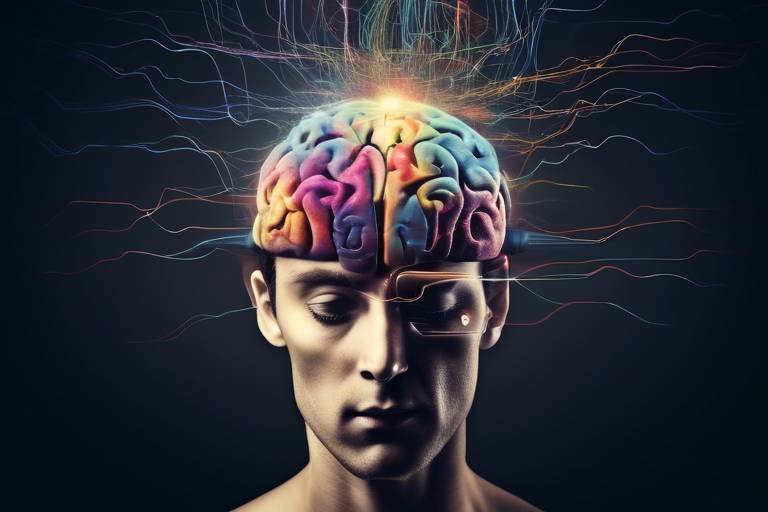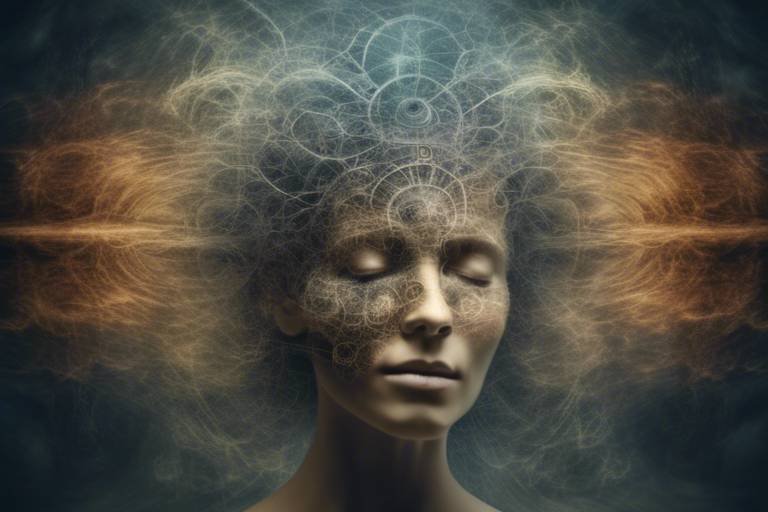Mind, Body, and Soul - An Integral Approach
In today’s fast-paced world, the concept of well-being often gets lost in the hustle and bustle of daily life. We tend to compartmentalize our existence, focusing heavily on our physical health while neglecting the profound connections between our mind, body, and soul. However, recognizing that these elements are intricately intertwined is essential for achieving true harmony and personal growth. Think of it like a three-legged stool: if one leg is shorter or weaker, the entire structure becomes unstable. This article explores the interconnectedness of these three facets, emphasizing the importance of a holistic approach to well-being.
The journey to understanding this connection starts with the mind. Our thoughts, beliefs, and emotions significantly influence our physical health. For instance, stress and anxiety can manifest as physical ailments, while positive thinking can lead to improved health outcomes. It’s fascinating how our mental state can act as a catalyst for healing or, conversely, for illness. By nurturing our minds, we can create a ripple effect that promotes physical wellness and nourishes our souls.
But what does it mean to nurture the soul? The soul represents our deeper self, our purpose, and our connection to the universe. Engaging in practices that foster spiritual growth can lead to a profound sense of fulfillment and belonging. When we integrate practices that nurture our mind, body, and soul, we embark on a transformative journey that enhances our overall well-being.
In the following sections, we will delve deeper into the mind-body connection, holistic health practices, and methods to nurture the soul. Through this exploration, we aim to equip you with insights and practices that not only enhance your well-being but also empower you to lead a more balanced and fulfilling life.
Understanding how our mental state influences physical health is crucial. This section delves into the science behind the mind-body connection and its implications for overall wellness.
Integrative health practices encompass various approaches, including yoga, meditation, and nutrition. Here, we examine how these practices contribute to a balanced mind, body, and soul.
Meditation serves as a powerful tool for mental clarity and emotional stability. This subsection outlines various meditation techniques that promote mindfulness and inner peace.
Mindfulness meditation encourages present-moment awareness, helping individuals manage stress and anxiety. We explore its benefits and practical steps to incorporate it into daily life.
Guided visualization techniques can enhance relaxation and motivation. This section explains how to use imagery to foster positive mental states and achieve personal goals.
Physical health is a cornerstone of overall well-being. Discover the importance of exercise, nutrition, and sleep in maintaining a healthy body and mind.
The soul represents our deeper self and purpose. This section discusses practices that nurture the soul, fostering a sense of fulfillment and connection.
Engaging in spiritual practices can enhance personal growth and self-awareness. Here, we explore various spiritual traditions and their relevance to modern life.
Creative outlets, such as art and writing, can nourish the soul. This subsection highlights the therapeutic benefits of creative expression for emotional and spiritual well-being.
- What is the mind-body connection?
The mind-body connection refers to the relationship between our mental state and physical health. It emphasizes how our thoughts and emotions can influence our physical well-being.
- How can I improve my mental health?
Practices such as meditation, exercise, and maintaining a balanced diet can significantly improve mental health. Engaging in activities that bring joy and fulfillment also plays a crucial role.
- What are some ways to nurture my soul?
Nurturing your soul can involve spiritual practices, creative expression, and connecting with nature. Finding activities that resonate with your inner self is key.

The Mind-Body Connection
The concept of the mind-body connection is not just a trendy buzzword; it's a profound realization that our mental and emotional states have a direct impact on our physical health. Imagine your mind as a powerful conductor, orchestrating the symphony of your body. When you're feeling stressed or anxious, it's as if the conductor has lost the rhythm, causing chaos in the performance of your body's systems. This connection is backed by science, highlighting how our thoughts and feelings can manifest in physical symptoms. For instance, have you ever noticed how your heart races when you're anxious? That's your mind influencing your body in real-time!
Research in the field of psychoneuroimmunology shows that our mental state can affect our immune system, hormones, and even our overall longevity. When we experience chronic stress, our body releases hormones like cortisol, which can lead to a range of health issues, including hypertension, diabetes, and heart disease. On the flip side, positive mental states can boost our immune response and promote healing. It's like having a personal trainer in your head, cheering you on to better health!
To truly understand the mind-body connection, we need to consider several factors:
- Emotional Health: Emotions like joy, sadness, and anger can trigger physical responses. For example, feeling happy can increase endorphins, while prolonged sadness can lead to fatigue.
- Stress Management: Learning to manage stress through techniques like meditation and deep breathing can significantly improve physical health.
- Thought Patterns: Negative thought patterns can lead to a cycle of self-doubt and physical tension, while positive affirmations can enhance resilience and well-being.
So, how do we harness this connection for better health? It starts with awareness. By tuning into our bodies and recognizing the signs of stress or discomfort, we can take proactive steps to address them. This might mean practicing mindfulness, engaging in physical activity, or even simply taking a moment to breathe deeply and reset. Just as a gardener tends to their plants to ensure they flourish, we must nurture our minds and bodies to cultivate a thriving existence.
Incorporating holistic practices into our daily routines can create a harmonious balance between mind and body. Activities such as yoga, tai chi, or even a brisk walk can help bridge the gap between mental and physical health. These practices encourage us to be present, connecting our thoughts with our physical sensations, ultimately leading to a more integrated sense of well-being.
In conclusion, the mind-body connection is a powerful reminder of the intricate relationship between our thoughts, emotions, and physical health. By fostering this connection, we can enhance our overall wellness and lead a more fulfilling life. So, take a moment today to check in with yourself—how are you feeling mentally, and how is that affecting your body? Remember, it's all connected!

Holistic Health Practices
When we think about health, we often focus on the physical aspect—exercising, eating right, and getting enough sleep. However, the truth is that our well-being is like a three-legged stool, supported by the mind, body, and soul. To achieve true balance, we must embrace that nurture each of these facets. Integrative health practices are not just a trend; they are a way of life that promotes comprehensive wellness. By incorporating methods such as yoga, meditation, and mindful nutrition into our daily routines, we can create a harmonious environment that fosters personal growth and overall vitality.
Yoga, for instance, is more than just a series of poses. It's a practice that connects the breath with movement, allowing us to cultivate awareness of our bodies and minds. Through yoga, we can release physical tension and emotional stress, leading to a profound sense of peace. Similarly, meditation serves as a powerful tool for mental clarity and emotional stability. It invites us to pause, breathe, and reflect, creating space for our thoughts and feelings to settle. This practice not only enhances our focus but also reduces anxiety and promotes a more positive outlook on life.
Nutrition plays a pivotal role in our holistic health journey as well. Eating a balanced diet rich in whole foods fuels our bodies and minds, providing the nutrients necessary for optimal functioning. It's essential to understand that what we consume can significantly impact our mood and energy levels. By choosing nourishing foods, we can elevate our mental state and support our physical health. Here’s a quick look at some key elements of a holistic approach to nutrition:
| Food Group | Benefits |
|---|---|
| Fruits and Vegetables | Rich in vitamins, minerals, and antioxidants; boost immunity and energy. |
| Whole Grains | Provide sustained energy and support digestive health. |
| Healthy Fats | Essential for brain health and hormone regulation. |
| Lean Proteins | Support muscle repair and overall bodily functions. |
Incorporating these elements into our daily meals can profoundly affect our overall well-being. However, it’s not just about what we eat; it’s also about how we eat. Practicing mindful eating—taking the time to savor each bite and listen to our body’s hunger cues—can transform our relationship with food.
Ultimately, embracing holistic health practices means recognizing that our well-being is interconnected. By nurturing our mind, body, and soul, we create a foundation for a fulfilling life. It’s about being proactive in our health journey and understanding that every small step we take contributes to a larger picture of wellness. So, why not start today? Dive into yoga, try meditation, or make a conscious effort to eat mindfully. Your body, mind, and soul will thank you!
- What are holistic health practices? Holistic health practices encompass various approaches that consider the interconnectedness of the mind, body, and soul.
- How can I start practicing yoga? You can start by joining a local class, following online tutorials, or simply practicing at home with guided videos.
- What type of meditation is best for beginners? Mindfulness meditation is often recommended for beginners because it focuses on the present moment and is easy to practice.
- Can nutrition really affect my mental health? Absolutely! A balanced diet rich in nutrients can enhance mood, reduce anxiety, and improve overall mental clarity.

Meditation Techniques
Meditation serves as a powerful tool for mental clarity and emotional stability, acting as a sanctuary for the mind amidst the chaos of everyday life. Just like a well-tuned instrument, our minds need regular practice and nurturing to perform at their best. By incorporating various meditation techniques into your routine, you can cultivate a profound sense of peace and awareness. So, let’s dive into some effective meditation methods that can transform your mental landscape.
One popular technique is mindfulness meditation, which encourages practitioners to focus on the present moment. Imagine sitting quietly, observing your thoughts as if they were clouds floating across the sky. You’re not trying to change or judge them; you’re simply acknowledging their presence. This practice helps in managing stress and anxiety, allowing you to develop a deeper connection with your thoughts and emotions. Research shows that mindfulness meditation can lead to improved focus, reduced emotional reactivity, and a greater sense of overall well-being.
Another effective method is guided visualization. Think of it as a mental movie where you’re the director, and you can create any scene you desire. This technique involves using imagery to foster positive mental states and achieve personal goals. For instance, you might visualize yourself achieving a significant milestone or simply relaxing on a serene beach. The beauty of guided visualization lies in its ability to enhance relaxation and motivation by engaging your imagination. You can either follow a recorded session or create your own script to guide you through the experience.
Here’s a brief overview of how to practice these techniques:
| Technique | Description | Benefits |
|---|---|---|
| Mindfulness Meditation | Focus on the present moment without judgment. | Reduces stress and anxiety, enhances emotional regulation. |
| Guided Visualization | Use imagery to create positive mental scenarios. | Increases relaxation, boosts motivation, and enhances creativity. |
Incorporating these techniques into your daily routine doesn’t have to be overwhelming. Start small; even just a few minutes each day can lead to significant improvements in your mental health. You might find it helpful to set aside a specific time each day for meditation, creating a sacred space where you can unwind and reconnect with yourself. Over time, as you deepen your practice, you’ll likely discover that meditation not only calms your mind but also enriches your life in ways you never imagined.
In conclusion, meditation techniques such as mindfulness and guided visualization can serve as vital components of your holistic health journey. By embracing these practices, you’re not just investing in your mental well-being; you’re also nurturing your body and soul, paving the way for a more balanced and fulfilling life.
- How long should I meditate each day? It’s recommended to start with just 5-10 minutes and gradually increase as you feel comfortable.
- Do I need to sit in a specific position to meditate? While traditional meditation often involves sitting cross-legged, you can meditate in any comfortable position that allows you to relax.
- Can meditation help with anxiety? Yes, many studies have shown that meditation can significantly reduce symptoms of anxiety and improve emotional regulation.

Mindfulness Meditation
Mindfulness meditation is like a gentle breeze that sweeps away the clutter of our busy minds, allowing us to focus on the present moment. It’s an art of being fully aware, where we tune into our thoughts, feelings, and sensations without judgment. Imagine standing on the shore, feeling the sand between your toes and the waves lapping at your feet; that's the kind of presence mindfulness meditation cultivates. It’s not just about sitting cross-legged and chanting; it’s about immersing yourself in the here and now.
One of the most beautiful aspects of mindfulness meditation is its accessibility. You don’t need to be a seasoned yogi or have hours to spare. Just a few minutes a day can make a world of difference. Studies have shown that regular practice can lead to reduced stress, improved focus, and even enhanced emotional resilience. When we practice mindfulness, we learn to observe our thoughts like clouds passing in the sky, acknowledging them without getting swept away by them.
To get started, find a quiet space where you can sit comfortably. Close your eyes and take a deep breath in, feeling your chest rise. As you exhale, let go of any tension. Now, focus on your breath. Inhale deeply, feeling the air fill your lungs, and exhale slowly, releasing any worries. If your mind wanders, gently guide it back to your breath. This simple practice can transform your day, helping you respond to challenges with a calm and centered mindset.
Mindfulness meditation can also be integrated into daily activities. Here are some practical ways to weave mindfulness into your routine:
- Mindful Eating: Savor each bite, noticing the flavors and textures of your food.
- Mindful Walking: Pay attention to the sensation of your feet touching the ground and the rhythm of your breath.
- Mindful Listening: When conversing, focus fully on the speaker without formulating your response while they talk.
As you embrace mindfulness meditation, you may start to notice subtle changes in your life. Perhaps you’ll find yourself reacting less impulsively, or maybe you'll experience a deeper connection with the world around you. It’s like turning on a light in a dim room; suddenly, everything seems clearer and more vibrant. Remember, the journey of mindfulness is personal and unique to each individual. There’s no right or wrong way to practice; what matters is your commitment to being present.
In conclusion, mindfulness meditation is a powerful tool for enhancing our mental well-being. By dedicating just a few minutes each day to this practice, we can cultivate a sense of peace and clarity that permeates our lives. So, why not give it a try? Dive into the beautiful world of mindfulness and discover the transformative power it holds.
1. How long should I meditate for?
While even a few minutes can be beneficial, starting with 10-15 minutes a day is a great goal. As you become more comfortable, you can gradually increase the duration.
2. Do I need to sit in a specific position?
No, you can sit in any comfortable position. The key is to keep your back straight and your body relaxed.
3. What if my mind keeps wandering?
It's completely normal for your mind to wander. When it does, gently bring your focus back to your breath or the present moment without judgment.
4. Can mindfulness meditation help with anxiety?
Yes, many people find that mindfulness meditation helps reduce feelings of anxiety by promoting a sense of calm and grounding.
5. How can I incorporate mindfulness into my daily life?
You can practice mindfulness during everyday activities like eating, walking, or even washing dishes by focusing fully on the task at hand.

Guided Visualization
Guided visualization is a remarkable technique that harnesses the power of our imagination to promote relaxation, motivation, and overall well-being. Imagine being able to transport yourself to a serene beach, feeling the warm sun on your skin and hearing the gentle waves lapping at the shore. This isn’t just daydreaming; it’s a structured practice that can significantly enhance your mental state and emotional health. By using vivid imagery, you can create a mental landscape that not only calms the mind but also fuels your aspirations.
So, how does guided visualization work? At its core, this practice involves listening to a facilitator who leads you through a series of visual scenarios designed to evoke specific feelings and responses. Whether you seek relaxation or motivation, guided visualization can be tailored to meet your unique needs. Here’s a simple breakdown of the process:
- Find a Quiet Space: Choose a comfortable, quiet location where you won’t be disturbed.
- Close Your Eyes: This helps to minimize distractions and allows you to focus inward.
- Listen to a Guide: Use audio recordings or a live facilitator to guide you through the visualization.
- Engage Your Senses: Actively imagine the sights, sounds, and feelings associated with the scenario.
- Reflect: After the session, take a moment to reflect on your experience and any emotions that surfaced.
One of the most significant benefits of guided visualization is its ability to reduce stress and anxiety. When you immerse yourself in a peaceful mental image, your body responds by lowering cortisol levels, which can lead to a calmer state of mind. Furthermore, visualization can enhance your motivation by helping you visualize your goals and the steps needed to achieve them. It’s like creating a mental movie of your future success, which can make those goals feel more attainable.
Moreover, guided visualization can be particularly effective for athletes and performers. By visualizing success in their respective fields, they can mentally rehearse their performances, leading to improved outcomes in real-life situations. This technique is not only for the elite; anyone can benefit from taking a few minutes each day to visualize their goals and aspirations.
In conclusion, guided visualization is a powerful tool that can lead to profound changes in your mental and emotional well-being. By dedicating time to this practice, you can cultivate a deeper sense of peace, clarity, and motivation in your life. So why not give it a try? Set aside a few minutes today to close your eyes, breathe deeply, and visualize your dreams coming to life.
Q: How often should I practice guided visualization?
A: It’s recommended to practice guided visualization regularly, whether that’s daily or a few times a week, to reap the full benefits.
Q: Can guided visualization help with anxiety?
A: Yes, many people find that guided visualization helps reduce anxiety by promoting relaxation and providing a mental escape.
Q: Do I need to be an expert to try guided visualization?
A: Absolutely not! Guided visualization is accessible to everyone, regardless of experience. Just follow along with a guide, and you’ll be on your way.
Q: What if I can’t visualize well?
A: That’s perfectly okay! Even if you struggle with visualization, you can still benefit from the practice by focusing on the feelings and sensations rather than detailed images.

Physical Wellness
When we talk about , we're diving into a world where our body, mind, and soul harmoniously coexist. Imagine your body as a finely tuned instrument; if one string is out of tune, the entire melody suffers. This is why maintaining physical wellness is not just about hitting the gym or eating salads—it's about creating a lifestyle that promotes overall vitality. It’s the foundation upon which our mental clarity and emotional stability rest. So, what does it really take to achieve this balance?
First off, let’s discuss the importance of exercise. Regular physical activity is like a magic potion for your body. It boosts your mood, increases your energy levels, and even sharpens your mind. Whether it’s a brisk walk in the park, a dance class, or lifting weights at the gym, finding an activity you enjoy can make all the difference. The key is consistency; aim for at least 150 minutes of moderate aerobic activity each week, as recommended by health experts. But remember, it's not just about quantity; quality matters too. Engaging in activities that elevate your heart rate and challenge your muscles is essential for building strength and endurance.
Now, let’s not forget about nutrition. Think of food as the fuel that powers your body. Eating a balanced diet rich in fruits, vegetables, whole grains, and lean proteins can significantly impact your physical wellness. It’s not just about counting calories; it’s about nourishing your body with the right nutrients. Here’s a quick breakdown of what a balanced plate might look like:
| Food Group | Examples | Benefits |
|---|---|---|
| Fruits & Vegetables | Apples, Spinach, Berries | Rich in vitamins, minerals, and antioxidants |
| Whole Grains | Brown Rice, Quinoa, Oats | Provides energy and fiber for digestion |
| Proteins | Chicken, Fish, Legumes | Essential for muscle repair and growth |
Additionally, let’s talk about sleep. Often overlooked, sleep is crucial for physical recovery and mental sharpness. It’s during these hours of rest that your body repairs itself and your brain processes the information from the day. Aim for 7-9 hours of quality sleep each night. If you find it hard to wind down, consider creating a bedtime routine that promotes relaxation—think warm baths, reading, or gentle stretches before sleep.
Lastly, let’s not dismiss the importance of hydration. Water is vital for every cell in your body. It aids digestion, keeps your skin glowing, and helps regulate body temperature. Aim to drink at least 8 glasses of water a day, but remember that your individual needs may vary based on your activity level and climate. Keeping a reusable water bottle handy can serve as a constant reminder to hydrate throughout the day.
In summary, achieving physical wellness is a multifaceted endeavor that requires attention to exercise, nutrition, sleep, and hydration. By integrating these elements into your daily routine, you are not just enhancing your physical health but also laying the groundwork for a balanced mind and soul. Remember, it’s not about perfection; it’s about progress. Small, consistent changes can lead to significant improvements over time. So, why not start today? Your body will thank you!
- What types of exercise are best for physical wellness? Aim for a mix of cardio, strength training, and flexibility exercises.
- How can I improve my sleep quality? Establish a regular sleep schedule, create a calming bedtime routine, and limit screen time before bed.
- What should I eat for better physical health? Focus on a balanced diet rich in whole foods, including fruits, vegetables, lean proteins, and whole grains.
- How much water should I drink daily? A general guideline is about 8 glasses (64 ounces), but individual needs may vary.

Nurturing the Soul
Nurturing the soul is akin to tending to a delicate garden; it requires patience, love, and a bit of creativity. Our soul is the essence of who we are, encompassing our beliefs, values, and deeper sense of purpose. When we invest time and energy into nurturing our soul, we cultivate a profound sense of fulfillment and connection to the world around us. But how do we go about this? The answer lies in a variety of practices that resonate with our individual needs and aspirations.
One of the most effective ways to nurture the soul is through spiritual practices. Engaging in activities such as meditation, prayer, or community service can create a deeper sense of connection—not just with ourselves, but with others and the universe. These practices help us reflect on our values, explore our beliefs, and find meaning in our daily lives. For instance, many people find that spending time in nature, whether it’s a walk in the park or a hike in the mountains, can be a deeply spiritual experience that rejuvenates the soul.
Additionally, creative expression serves as a vital outlet for nurturing the soul. Think of art, music, or writing as the soul’s voice—each stroke of a brush, note of a song, or word on a page carries the potential to express our innermost feelings. Engaging in creative activities not only allows for self-expression but also provides therapeutic benefits, helping to alleviate stress and enhance emotional well-being. For example, consider the joy that comes from painting a canvas or crafting a story; it’s a way to channel our thoughts and emotions into something tangible and beautiful.
Furthermore, nurturing the soul often involves fostering connections with others. Building and maintaining meaningful relationships can provide a sense of belonging and support, which is essential for our emotional health. Whether through family gatherings, friendships, or community involvement, these connections enrich our lives and deepen our understanding of ourselves and others. In fact, studies have shown that individuals with strong social ties tend to have a greater sense of purpose and overall happiness.
In summary, nurturing the soul is a multifaceted endeavor that encompasses spiritual practices, creative expression, and meaningful relationships. By taking the time to engage in these activities, we can enhance our personal growth and cultivate a deeper sense of fulfillment in our lives. Remember, nurturing your soul is not just an occasional task; it’s an ongoing journey that invites you to explore and embrace the depths of your being.
- What are some simple ways to nurture my soul?
Simple practices include spending time in nature, journaling your thoughts and feelings, practicing gratitude, and engaging in creative activities. - How can spiritual practices benefit my overall well-being?
Spiritual practices can enhance your self-awareness, reduce stress, and foster a sense of connection with something greater than yourself. - Can creative expression really impact my emotional health?
Absolutely! Engaging in creative activities can serve as a therapeutic outlet, helping you process emotions and express feelings that may be difficult to articulate. - Why are meaningful relationships important for nurturing the soul?
Meaningful relationships provide support, love, and a sense of belonging, all of which are essential for emotional health and personal growth.

Spiritual Practices
Engaging in can be a transformative journey that elevates our understanding of ourselves and our place in the universe. These practices are not just rituals; they are pathways to deeper self-awareness and personal growth. Whether through meditation, prayer, or community involvement, spirituality can enhance our emotional and psychological well-being, providing a sense of purpose and connection.
One of the most accessible spiritual practices is meditation. This age-old technique allows individuals to quiet the mind, reflect inwardly, and connect with their true essence. By setting aside just a few minutes each day, you can cultivate a profound sense of peace and clarity. But meditation isn't a one-size-fits-all approach. There are various styles you can explore, such as mindfulness meditation, which emphasizes being present in the moment, or loving-kindness meditation, which focuses on generating feelings of compassion towards oneself and others.
Another powerful spiritual practice is community service. Engaging in acts of kindness not only benefits those around us but also enriches our own lives. When we help others, we tap into a deep well of compassion and empathy, which can foster a sense of interconnectedness. Consider volunteering at a local shelter or participating in community clean-up events. These activities not only support those in need but also create a shared experience that can enhance your spiritual journey.
Additionally, nature can serve as a profound spiritual guide. Many people find solace and inspiration in the great outdoors. Whether it's a walk in the park, hiking in the mountains, or simply sitting by a river, nature has a unique way of grounding us and reminding us of the beauty and complexity of life. The sights, sounds, and smells of the natural world can awaken a sense of wonder and reverence that feeds the soul.
Spirituality can also be nurtured through creative expression. Engaging in artistic endeavors—be it painting, writing, or playing music—allows for a deeper exploration of emotions and thoughts. These creative outlets can serve as a form of meditation, where the act of creating becomes a spiritual practice in itself. It’s not about the end product; it’s about the journey of expression and self-discovery. Many find that their most profound insights arise during these moments of creative flow.
Incorporating spiritual practices into your daily routine doesn’t have to be overwhelming. Here are a few simple ways you can start:
- Set aside a few minutes each day for meditation.
- Engage in community service once a month.
- Spend time in nature regularly, allowing it to inspire and rejuvenate you.
- Explore your creative side through art, writing, or music.
Ultimately, the journey of spirituality is deeply personal and unique to each individual. It’s about finding what resonates with you and nurturing that connection. As you explore various spiritual practices, remember that the goal is not perfection but rather a deeper understanding of yourself and your place in the world. Embrace the journey, and you may find that it leads you to unexpected places filled with joy, peace, and fulfillment.
Q: What are some easy ways to start incorporating spiritual practices into my life?
A: You can begin by dedicating a few minutes each day to meditation, engaging in acts of kindness, spending time in nature, or exploring creative outlets like painting or writing.
Q: Do I need to follow a specific religion to engage in spiritual practices?
A: Not at all! Spirituality is a personal journey that can be tailored to your beliefs and experiences. You can draw from various traditions or create your own unique practices.
Q: How can I measure the impact of spiritual practices on my life?
A: While spirituality is often subjective, many people report increased feelings of peace, purpose, and connection as they engage in spiritual practices. Keeping a journal can help you track your feelings and experiences over time.

Creative Expression
Creative expression is not just a hobby; it’s a vital part of our existence that allows us to connect with our inner selves and the world around us. Think of it as a bridge that links our emotions, thoughts, and experiences into something tangible. Whether it's painting, writing, dancing, or playing music, each form of creative expression serves as a unique outlet for our feelings and thoughts. It’s like breathing life into our innermost feelings, transforming them into something beautiful and meaningful.
Engaging in creative activities can have profound effects on our emotional and spiritual well-being. When we create, we tap into a well of inspiration that can lead to personal growth and healing. For instance, studies have shown that artistic activities can significantly reduce stress levels and promote relaxation. It’s almost like a meditation, where the act of creating allows us to enter a state of flow, freeing our minds from the clutter of daily life. This process not only enhances our mood but also fosters a deeper understanding of ourselves.
Moreover, creative expression can serve as a powerful tool for self-discovery. When we engage in creative activities, we often uncover hidden aspects of ourselves that we may not have been aware of before. This journey of exploration can lead to greater self-awareness and a stronger sense of identity. Here are some benefits of creative expression:
- Emotional Release: It provides a safe space to express feelings that might be difficult to articulate verbally.
- Increased Confidence: Completing a creative project can boost self-esteem and a sense of accomplishment.
- Enhanced Problem-Solving Skills: Creativity encourages thinking outside the box, improving our ability to solve problems.
- Connection with Others: Sharing creative work can forge connections and foster community.
Additionally, creative expression can be therapeutic. Many therapists incorporate art and music therapy into their practices, recognizing the healing power of creativity. This approach allows individuals to process their emotions in a non-verbal way, which can be particularly beneficial for those who struggle to articulate their feelings. It’s fascinating how a simple brush stroke or a few written words can convey emotions that words alone sometimes cannot. In this sense, creativity becomes a language of its own, speaking volumes about our inner worlds.
To truly harness the benefits of creative expression, it’s essential to make it a regular part of our lives. Here are a few practical tips to get started:
- Set aside dedicated time each week for creative activities.
- Don’t worry about the outcome; focus on the process and enjoy it.
- Explore different mediums to find what resonates with you the most.
- Join a community or group to share your work and gain inspiration from others.
In conclusion, embracing creative expression is a beautiful way to nurture our souls. It allows us to explore our identities, release emotions, and connect with others. So, grab that paintbrush, write that story, or play that song! Remember, the journey of creativity is just as important as the destination. Let your imagination run wild, and watch as it transforms your life in ways you never thought possible.
Q: How can I start incorporating creative expression into my daily life?
A: Begin by setting aside a few minutes each day to engage in a creative activity that you enjoy, whether it's doodling, journaling, or playing an instrument. The key is consistency and allowing yourself to explore without judgment.
Q: What if I don’t consider myself “creative”?
A: Creativity is not limited to artists or musicians. Everyone has the potential to be creative in their unique way. Focus on activities that bring you joy and allow you to express yourself, regardless of your perceived talent.
Q: Can creative expression really improve my mental health?
A: Absolutely! Many studies support the idea that engaging in creative activities can reduce stress, alleviate anxiety, and promote overall emotional well-being. It acts as a form of self-care that nurtures both the mind and soul.
Frequently Asked Questions
- What is the mind-body connection?
The mind-body connection refers to the relationship between our mental state and physical health. It highlights how our thoughts, emotions, and psychological well-being can significantly impact our physical condition. For instance, stress can lead to physical ailments like headaches or digestive issues, showcasing the profound link between the two.
- How can I improve my mind-body connection?
Improving your mind-body connection can be achieved through various practices. Engaging in mindfulness meditation, regular physical exercise, and maintaining a balanced diet are excellent ways to enhance this relationship. Additionally, being aware of your thoughts and feelings can help you understand how they affect your body, leading to better overall health.
- What are some holistic health practices?
Holistic health practices encompass a range of approaches that promote overall well-being. Some popular methods include yoga, meditation, acupuncture, and nutritional therapy. These practices aim to balance the mind, body, and soul by addressing the individual as a whole rather than just treating specific symptoms.
- What is mindfulness meditation?
Mindfulness meditation is a technique that encourages present-moment awareness. It involves focusing on your breath and observing your thoughts without judgment. This practice can help reduce stress and anxiety, improve concentration, and promote emotional well-being, making it a valuable tool for anyone looking to enhance their mental health.
- How does physical wellness contribute to overall well-being?
Physical wellness is a cornerstone of overall well-being as it directly impacts our energy levels, mood, and mental clarity. Regular exercise, proper nutrition, and adequate sleep not only keep our bodies healthy but also enhance our mental and emotional states. When we feel good physically, it's easier to maintain a positive mindset and engage fully in life.
- What practices can nurture the soul?
Nurturing the soul involves engaging in activities that foster a sense of fulfillment and connection. Spiritual practices, such as meditation, prayer, or spending time in nature, can enhance self-awareness and personal growth. Additionally, creative expressions like painting, writing, or playing music can serve as powerful outlets for emotional and spiritual nourishment.
- Why is creative expression important for well-being?
Creative expression is vital for well-being as it allows individuals to process emotions and explore their inner thoughts. Engaging in creative activities can reduce stress, boost self-esteem, and provide a sense of accomplishment. Moreover, it can serve as a therapeutic tool, helping individuals connect with their deeper selves and find joy in the process of creation.



















